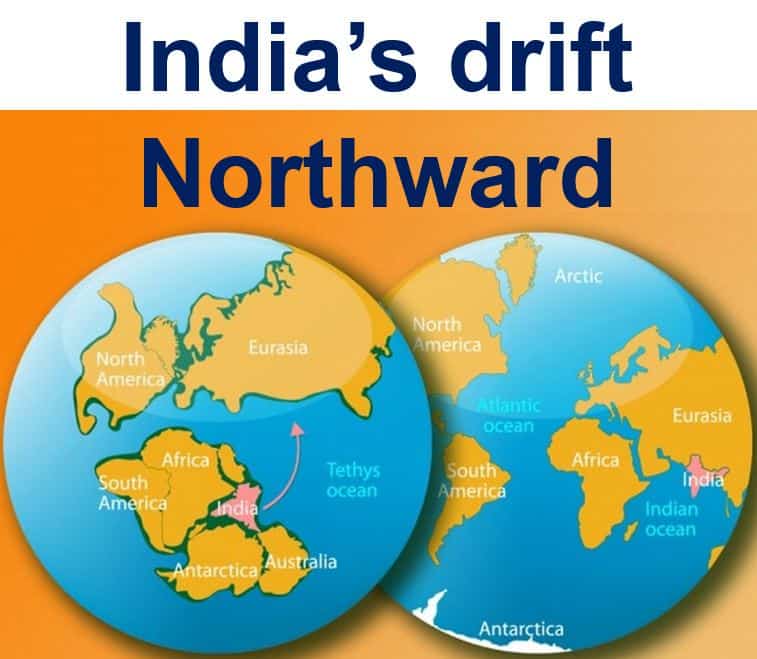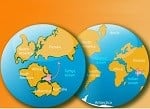Researchers can now explain how and when the Himalayas were formed, and why India drifted at such high speed. It all started about 120 years ago, when what is today India broke off from a massive continent called Gondwana and started moving northwards slowly, at approximately 5 centimetres per year.
Forty million years later, i.e. 80 million years ago, the land suddenly accelerated, moving northward at about 15 centimeters per year – which is about twice the speed of typical tectonic drift.
About fifty million years ago the continent collided with Eurasia, which gave rise to the Himalayas.
The researchers, from MIT and the University of Southern California published details of their study in the academic journal Nature Geoscience.

The left image shows what Earth looked like over 140 million years ago, when India was part of an massive supercontinent called Gondwana. The right image shows Earth today. (Source: MIT)
Scientists have long been unable to explain how India could have drifted northward so rapidly. The geologists say they have an answer: India was pulled northward by a combination of two subduction zones – regions within the Earth’s mantle where the edge of one tectonic plate sinks below another plate.
Two sinking plates had double the pulling force
The plate that sinks pulls along any connected landmasses. The scientists explained that two such sinking plates would pull twice as strongly, thus doubling India’s drift velocity.
Leigh Royden, a professor of geology and geophysics in MIT’s Department of Earth, Atmospheric and Planetary Sciences, and colleagues found relics of what could have been two subduction zones by sampling and dating rocks from the Himalayas.
They then created a model for a double subduction system, and concluded that India’s drift velocity those tens of millions of years ago could have depended on two factors within the system: the distance between the subduction plates and their width.
If the plates were relatively far apart and narrow, they would probably cause India to drift more rapidly.
Prof. Royden and colleagues incorporated the measurements they had obtained from the Himalayas into their new model, and found that a double subduction system could have driven India to drift at high velocity toward Eurasia about eighty million years ago.
Prof. Royden said:
“In earth science, it’s hard to be completely sure of anything. But there are so many pieces of evidence that all fit together here that we’re pretty convinced.”
What drives drift?
Based on the geological record, India’s shift appears to have begun approximately 120 million years ago, when Gondwana started breaking apart.
India was set adrift the Tethys Ocean – which was then an immense body of water that separated Eurasia from Gondwana.
India shifted along at an unremarkable speed of 40 millimetres per year around 80 million years ago, when it suddenly accelerated to 150 millimetres per year.
India continued moving at this much faster rate for another 30 million years, when it collided with Eurasia.
Prof. Royden said:
“When you look at simulations of Gondwana breaking up, the plates kind of start to move, and then India comes slowly off of Antarctica, and suddenly it just zooms across – it’s very dramatic.”
Four years ago, geologists thought they had identified what the driving force was behind India’s rapid drift: a plume of magma that welled up from the Earth’s mantle. The plume created a volcanic jet of material below India, allowing it to ‘surf’ at high speed, so the hypothesis suggested.
However, when other researchers modeled this scenario, they found that such volcanic activity could not have lasted more than five million years, which was nowhere near enough time to account for India’s 30 million years of high-speed drift.
Squeezing honey
Instead, Prof. Royden and Oliver Jagoutz, an associate professor of earth, atmospheric, and planetary sciences at MIT, believe that India’s rapid drift probably occurred as the result of the subduction of two plates: the tectonic plate carrying India and another plate in the middle of the Tethys Ocean.
The research team, which included 30 students, trekked through the Himalayas, gathered rocks and took paleomagnetic measurements to determine where the rocks originally formed.
The scientists’ data suggested that about eighty million years ago an arc of volcanoes formed close to the equator, which was then in the middle of the Tethys Ocean.
A volcanic arc is usually a sign of a subduction zone, and the researchers identified a second volcanic arc south of the first one, where India first started breaking away from Gondwana.
The data suggested there could have been two subducting plates: a southern tectonic plate which carried India, and a northern oceanic plate.
Back at MIT, professors Jagoutz and Royden developed a model of double subduction involving a southern and northern plate.
They calculated how the plates would shift as each subducted (sank) into the Earth’s mantle. When plates sink, they squeeze material out between their edges. The amount of material that can be squeezed out can determine the speed at which a plate migrates.
Plates that are relatively far apart and narrow can squeeze out more material, the team calculated, resulting in a more rapid drift.
Prof. Royden said:
“Imagine it’s easier to squeeze honey through a wide tube, versus a very narrow tube. It’s exactly the same phenomenon.”
According to Jagoutz’ and Royden’s measurements from the Himalayas, the northern oceanic plate remained extremely wide, spanning almost one-third of the Earth’s circumference.
The southern plate, however, the one carrying India, underwent a radical change. Approximately 80 million years ago, a collision with Africa reduced that plate to 3,000 kilometres – at about the time India started to drift more rapidly.
The geologists believe the smaller plate allowed more material to escape between the two plates. Based on the dimensions of the two plates, they calculated that India would have accelerated from fifty to 150 millimetres per year.
Other studies have calculated similar rates for India’s drift. However, this is the first to provide compelling evidence that double subduction acted at its driving force.
Prof. Jagoutz, who sees the results as a starting point for a new set of questions, said:
“It’s a lucky coincidence of events. There were a lot of changes going on in that time period, including climate, that may be explained by this phenomenon. So we have a few ideas we want to look at in the future.”
Citation: “Anomalously fast convergence of India and Eurasia caused by double subduction,” Oliver Jagoutz, Leigh Royden, Adam F. Holt & Thorsten W. Becker. Nature Geoscience. Published 4 May 2015. DOI: 10.1038/ngeo2418.

